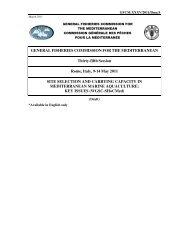English
English
English
Create successful ePaper yourself
Turn your PDF publications into a flip-book with our unique Google optimized e-Paper software.
13<br />
GFCM:SAC13/2011/Dma2<br />
Within the Mediterranean, the distribution of elasmobranch fishes is not homogenous (Serena,<br />
2005). Some areas are considered critical habitat for elasmobranchs. For example, Tunisian<br />
waters provide a nursery area for great white shark Carcharodon carcharias, the sandbar<br />
shark Carcharhinus plumbeus and probably for many other species (saidi, 2008 and Enajjar,<br />
2009). Some species have a restricted range within the Mediterranean, for example a small<br />
population of the smalltooth sand tiger shark Odontaspis ferox seems resident in a particular<br />
area off Lebanon (Canavagh & Gibson, 2007). In the Adriatic Sea, the presence of<br />
cartilaginous fish species is scarce especially in the northern part. The basking shark is a<br />
rather rare but constantly present species in the eastern Adriatic Sea. However, over the<br />
period 2000-2002 their occurrence in that area highly increased (Soldo et al., 2008). Besides<br />
its oceanographic characteristics that may limit biodiversity, this area was populated more<br />
recently than other parts of the Mediterranean. A total of 52 species of cartilaginous fish have<br />
been recorded in the Adriatic Sea. Only 10 species are widely distributed. Some bathyal<br />
species of the group inhabit exclusively the central and southern parts of this sea (Serena,<br />
2005). In the Black Sea the number of cartilaginous fish species is lower. The Black Sea<br />
fauna is composed of Mediterranean species and most of the organisms present are<br />
eurythermic and euryhaline. Thirteen elasmobranchs species are assumed to live in the Black<br />
Sea (Serena, 2005). However, it should be noted that several species of elasmobranchs have<br />
been reported in the Marmara Sea which is with the Black Sea and Sea of Azov in the same<br />
FAO sub-area: Black Sea sub-area.<br />
Precisions on spatial distribution of some species<br />
- Carcharhinus obscurus<br />
The species is an occasional transient within the Mediterranean, it was recorded in Malta<br />
(Fergusson and Compagno, 2000), the Gulf of Gabès (Saïdi, 2008), in Syria (Saad et al.,<br />
2004) and in Palestine (Golani, 2005). Based on the capture data, the species may occupy a<br />
wider range than supposed.<br />
- Carcharhinus brachyurus<br />
The species was not cited along the oriental basin. It’s occurrence in the Mediterranean Sea<br />
may be confined only in the occidental basin. It was recorded in Algerian coast (Hemida et<br />
al., 2002) and in Balearic Islands (Moery & Massuti, 2003).<br />
- Carcharhinus taurus.<br />
The occurrence of the species seems to be restricted to occidental basin. However, the species<br />
is probably disappearing from the area (Fregusson et al., 2000).<br />
- Echinorhinus brucus<br />
In the oriental basin, the species occurred only on the north coast of the Mediterranean Sea. It<br />
was recorded in the Sea of Marmara (Kabasakal, 2003). The species was not observed along<br />
the southern coasts of oriental basin.
















